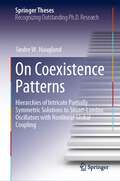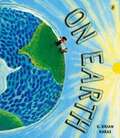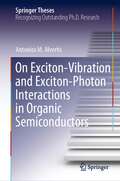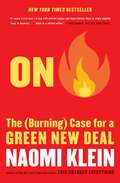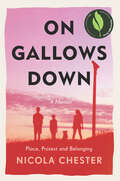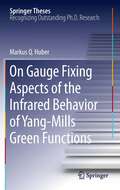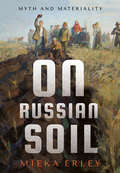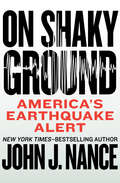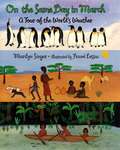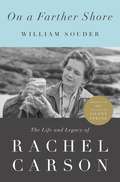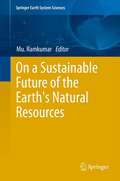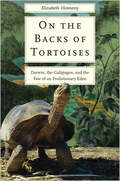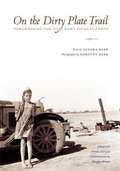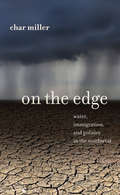- Table View
- List View
On Coexistence Patterns: Hierarchies of Intricate Partially Symmetric Solutions to Stuart-Landau Oscillators with Nonlinear Global Coupling (Springer Theses)
by Sindre W. HauglandThis book is about coexistence patterns in ensembles of globally coupled nonlinear oscillators. Coexistence patterns in this respect are states of a dynamical system in which the dynamics in some parts of the system differ significantly from those in other parts, even though there is no underlying structural difference between the different parts. In other words, these asymmetric patterns emerge in a self-organized manner. As our main model, we use ensembles of various numbers of Stuart-Landau oscillators, all with the same natural frequency and all coupled equally strongly to each other. Employing computer simulations, bifurcation analysis and symmetry considerations, we uncover the mechanism behind a wide range of complex patterns found in these ensembles. Our starting point is the creation of so-called chimeras, which are subsequently treated within a new and broader context of related states.
On Earth
by G. Brian KarasClimb aboard a giant spaceship… the Earth! In glorious art, G. Brian Karas illuminates our Earth and its cycles and does a brilliant job of making the concepts of rotation and revolution understandable. As you travel, watch shadows disappear into night, and feel the sun on your face as winter turns into spring. All these amazing things happen because the Earth is constantly in motion, spinning and circling, gliding and tilting. As passengers of the Earth, our voyage never ends!
On Earth (Into Reading, Big Book Module 5)
by G. KarasNIMAC-sourced textbook <P><P>Perfect for Earth Day! Climb aboard a giant spaceship . . . the Earth! In glorious art, G. Brian Karas illuminates our Earth and its cycles and does a brilliant job of making the concepts of rotation and revolution understandable. As you travel, watch shadows disappear into night, and feel the sun on your face as winter turns into spring. All these amazing things happen because the Earth is constantly in motion, spinning and circling, gliding and tilting. As passengers of the Earth, our voyage never ends! <P><P>Lexile Measure: AD540L
On Exciton–Vibration and Exciton–Photon Interactions in Organic Semiconductors (Springer Theses)
by Antonios M. AlvertisWhat are the physical mechanisms that underlie the efficient generation and transfer of energy at the nanoscale? Nature seems to know the answer to this question, having optimised the process of photosynthesis in plants over millions of years of evolution. It is conceivable that humans could mimic this process using synthetic materials, and organic semiconductors have attracted a lot of attention in this respect. Once an organic semiconductor absorbs light, bound pairs of electrons with positively charged holes, termed `excitons’, are formed. Excitons behave as fundamental energy carriers, hence understanding the physics behind their efficient generation and transfer is critical to realising the potential of organic semiconductors for light-harvesting and other applications, such as LEDs and transistors. However, this problem is extremely challenging since excitons can interact very strongly with photons. Moreover, simultaneously with the exciton motion, organic molecules can vibrate in hundreds of possible ways, having a very strong effect on energy transfer. The description of these complex phenomena is often beyond the reach of standard quantum mechanical methods which rely on the assumption of weak interactions between excitons, photons and vibrations. In this thesis, Antonios Alvertis addresses this problem through the development and application of a variety of different theoretical methods to the description of these strong interactions, providing pedagogical explanations of the underlying physics. A comprehensive introduction to organic semiconductors is followed by a review of the background theory that is employed to approach the relevant research questions, and the theoretical results are presented in close connection with experiment, yielding valuable insights for experimentalists and theoreticians alike.
On Fire: The (Burning) Case for a Green New Deal
by Naomi Klein#1 New York Times and internationally bestselling author Naomi Klein makes the case for a Green New Deal in this &“keenly argued, well-researched, and impassioned&” manifesto (The Washington Post).An instant bestseller, On Fire shows Klein at her most prophetic and philosophical, investigating the climate crisis not only as a profound political challenge but also as a spiritual and imaginative one. Delving into topics ranging from the clash between ecological time and our culture of &“perpetual now,&” to the soaring history of humans changing and evolving rapidly in the face of grave threats, to rising white supremacy and fortressed borders as a form of &“climate barbarism,&” this is a rousing call to action for a planet on the brink. An expansive, far-ranging exploration that sees the battle for a greener world as indistinguishable from the fight for our lives, On Fire captures the burning urgency of the climate crisis, as well as the fiery energy of a rising political movement demanding a catalytic Green New Deal. &“Naomi Klein&’s work has always moved and guided me. She is the great chronicler of our age of climate emergency, an inspirer of generations.&” —Greta Thunberg, climate activist "If I were a rich man, I&’d buy 245 million copies of Naomi Klein&’s 'On Fire' and hand-deliver them to every eligible voter in America…Klein is a skilled writer." —Jeff Goodell, The New York Times
On Fire: The Burning Case for a Green New Deal
by Naomi KleinA MUST-READ book. Naomi Klein pairs a decade of her powerful writing on our acute environmental decline with new material on the staggeringly high stakes of what we choose to do next; and inspiringly offers here a politically viable, just, sustainable path forward.For more than twenty years, Naomi Klein has been the foremost chronicler of the economic war waged on both people and planet--and the champion of a sweeping environmental agenda with stability and justice at its center. In lucid dispatches from the frontlines--from the ghostly Great Barrier Reef, to the annual smoke-choked skies of the Pacific Northwest, to post-hurricane Puerto Rico, to a Vatican attempting an unprecedented "ecological conversion"--she has penned surging, indispensable lectures and essays for a wide public, with prescient, clarifying information about the future that awaits us and our children if we stick our heads in the sand. They show Klein at her most thoughtful, tracing the evolution of the climate crisis as the key issue of our time, not only as an immediate political challenge but as a spiritual and imaginative one too. Delving into topics ranging from the clash between ecological time and our culture of "perpetual now," to the soaring history of humans' ability to change rapidly in the face of grave threat, to rising white supremacy and fortressed borders as a form of "climate barbarism," this is a rousing call to action for a planet on the brink. Above all, she underscores how we can still rise to the existential challenge of the crisis if we are willing to transform our systems that are producing it, making clear how the battle for a greener world is indistinguishable from the fight for our lives. On Fire is a critical book: it captures the burning urgency of this moment, the fiery energy of a rising movement demanding change now, and lays out an inspiring vision for a sustainable future.
On Gaia: A Critical Investigation of the Relationship between Life and Earth
by Toby TyrrellA critical examination of James Lovelock's controversial Gaia hypothesisOne of the enduring questions about our planet is how it has remained continuously habitable over vast stretches of geological time despite the fact that its atmosphere and climate are potentially unstable. James Lovelock's Gaia hypothesis posits that life itself has intervened in the regulation of the planetary environment in order to keep it stable and favorable for life. First proposed in the 1970s, Lovelock's hypothesis remains highly controversial and continues to provoke fierce debate. On Gaia undertakes the first in-depth investigation of the arguments put forward by Lovelock and others—and concludes that the evidence doesn't stack up in support of Gaia.Toby Tyrrell draws on the latest findings in fields as diverse as climate science, oceanography, atmospheric science, geology, ecology, and evolutionary biology. He takes readers to obscure corners of the natural world, from southern Africa where ancient rocks reveal that icebergs were once present near the equator, to mimics of cleaner fish on Indonesian reefs, to blind fish deep in Mexican caves. Tyrrell weaves these and many other intriguing observations into a comprehensive analysis of the major assertions and lines of argument underpinning Gaia, and finds that it is not a credible picture of how life and Earth interact.On Gaia reflects on the scientific evidence indicating that life and environment mutually affect each other, and proposes that feedbacks on Earth do not provide robust protection against the environment becoming uninhabitable—or against poor stewardship by us.
On Gallows Down: Place, Protest and Belonging
by Nicola ChesterPart nature writing, part memoir, On Gallows Down is an essential, unforgettable read for fans of Helen Macdonald, Terry Tempest Williams, and Robin Wall Kimmerer. Nicola Chester won the BBC Wildlife Magazine’s Nature Writer of the Year Award – this is her first book. On Gallows Down is a powerful, personal story shaped by a landscape; one that ripples and undulates with protest, change, hope – and the search for home. From the girl catching the eye of the “peace women” of Greenham Common to the young woman protesting the loss of ancient and beloved trees, and as a mother raising a family in a farm cottage in the shadow of grand, country estates, this is the story of how Nicola Chester came to write – as a means of protest. The story of how she discovered the rich seam of resistance that runs through her village of Newbury and its people – from the English Civil War to the Swing Riots and the battle against the Newbury Bypass. And the story of the hope she finds in the rewilding of Greenham Common after the military left, the stories told by the landscapes of Watership Down, the gallows perched high on Inkpen Beacon and Highclere Castle (the setting of Downtown Abbey). Nature is indelibly linked to belonging for Nicola. She charts her story through the walks she takes with her children across the chalk hills of the North Wessex Downs, though the song of the nightingale and the red kites, fieldfares, skylarks and lapwings that accompany her; the badger cubs she watches at night; the velvety mole she discovers in her garden and the cuckoo, whose return she awaits. On Gallows Down tells of how Nicola came to realize that it is she who can decide where she belongs, for home is a place in nature and imagination, which must be protected through words and actions. "We are writing for our very lives and for those wild lives we share this one, lonely planet with."—Nicola Chester
On Gallows Down: Place, Protest and Belonging (Shortlisted for the Wainwright Prize 2022 for Nature Writing - Highly Commended)
by Nicola Chester"It’s ever so good. Political, passionate & personal."—Robert Macfarlane (via Twitter), author of UnderlandPart nature writing, part memoir, On Gallows Down is an essential, unforgettable read for fans of Helen Macdonald, Terry Tempest Williams, and Robin Wall Kimmerer."I couldn’t put it down! A must read!"—Dara McAnulty (via Twitter), author of Diary of a Young NaturalistNicola Chester won the BBC Wildlife Magazine’s Nature Writer of the Year Award – this is her first book.On Gallows Down is a powerful, personal story shaped by a landscape; one that ripples and undulates with protest, change, hope – and the search for home.From the girl catching the eye of the “peace women” of Greenham Common to the young woman protesting the loss of ancient and beloved trees, and as a mother raising a family in a farm cottage in the shadow of grand, country estates, this is the story of how Nicola Chester came to write – as a means of protest. The story of how she discovered the rich seam of resistance that runs through her village of Newbury and its people – from the English Civil War to the Swing Riots and the battle against the Newbury Bypass. And the story of the hope she finds in the rewilding of Greenham Common after the military left, the stories told by the landscapes of Watership Down, the gallows perched high on Inkpen Beacon and Highclere Castle (the setting of Downtown Abbey).Nature is indelibly linked to belonging for Nicola. She charts her story through the walks she takes with her children across the chalk hills of the North Wessex Downs, though the song of the nightingale and the red kites, fieldfares, skylarks and lapwings that accompany her; the badger cubs she watches at night; the velvety mole she discovers in her garden and the cuckoo, whose return she awaits. On Gallows Down tells of how Nicola came to realize that it is she who can decide where she belongs, for home is a place in nature and imagination, which must be protected through words and actions."We are writing for our very lives and for those wild lives we share this one, lonely planet with."—Nicola Chester
On Gauge Fixing Aspects of the Infrared Behavior of Yang-Mills Green Functions
by Markus Q. HuberQuarks are the main constituents of protons and neutrons and hence are important building blocks of all the matter that surrounds us. However, quarks have the intriguing property that they never appear as isolated single particles but only in bound states. This phenomenon is called confinement and has been a central research topic of elementary particle physics for the last few decades. In order to find the mechanism that forbids the existence of free quarks many approaches and ideas are being followed, but by now it has become clear that they are not mutually exclusive but illuminate the problem from different perspectives. Two such confinement scenarios are investigated in this thesis: Firstly, the importance of Abelian field components for the low-energy regime is corroborated, thus supporting the dual superconductor picture of confinement and secondly, the influence of the Gribov horizon on non-perturbative solutions is studied.
On Genetic Interests: Family, Ethnicity and Humanity in an Age of Mass Migration
by Frank SalterFrom an evolutionary perspective, individuals have a vi- tal interest in the reproduction of their genes. Yet this interest is overlooked by social and political theory at a time when we need to steer an adaptive course through the unnatural modern world of uneven population growth and decline, global mobility, and loss of family and communal ties. In modern Darwinian theory, bearing children is only one way to reproduce. Since we share genes with our families, ethnic groups, and the species as a whole, ethnocentrism and humanism can be adaptive. They can also be hazardous when taken to extremes. On Genetic Interests canvasses strategies and ethics for conserving our genetic interests in an environmentally sustainable manner sensitive to the interests of others.
On Our Watch: The Race To Save Australia's Environment
by Nicola MarkusOur stewardship of this country's natural assets over the past two hundred years has been appalling, and on the current trajectory of careless environmental pillaging, further massive decline would be a certainty . The future of the environment is being decided on our watch . Australia faces unique conservation challenges that most Australians do not know enough about. On Our Watch is an attempt to remedy this situation. Respected conservationist Nicola Markus believes that it is time people realised that our environmental issues are not being solved by those tasked with their solution, and that the support and involvement of the public is essential if we are to make a difference in environmental conservation. In this thoroughly researched and passionately written book, Markus explains the very real and immediate threats to Australia's natural environment and cuts through the spin to show how you can become involved in conserving our environmental heritage.
On Russian Soil: Myth and Materiality (NIU Series in Slavic, East European, and Eurasian Studies)
by Mieka ErleyBlending close readings of literature, films, and other artworks with analysis of texts of political philosophy, science, and social theory, Mieka Erley offers an interdisciplinary perspective on attitudes to soil in Russia and the Soviet Union from the early nineteenth to the mid-twentieth century. As Erley shows in On Russian Soil, the earth has inspired utopian dreams, reactionary ideologies, social theories, and durable myths about the relationship between nation and nature.In this period of modernization, soil was understood as the collective body of the nation, sitting at the crux of all economic and social problems. The "soil question" was debated by nationalists and radical materialists, Slavophiles and Westernizers, poets and scientists.On Russian Soil highlights a selection of key myths at the intersection of cultural and material history that show how soil served as a natural, national, and symbolic resource from Fedor Dostoevsky's native soil movement to Nikita Khrushchev's Virgin Lands campaign at the Soviet periphery in the 1960s. Providing an original contribution to ecocriticism and environmental humanities, Erley expands our understanding of how cultural processes write nature and how nature inspires culture.On Russian Soil brings Slavic studies into new conversations in the environmental humanities, generating fresh interpretations of literary and cultural movements and innovative readings of major writers.
On Shaky Ground: America's Earthquake Alert
by John J. NanceA &“gripping&” look at the massive disasters that could strike at any moment, from a New York Times–bestselling author (San Francisco Examiner-Chronicle). Far beneath the earth&’s surface, great tectonic plates grind against one another with incredible pressure that must—inevitably—be released. Earthquakes manifest with little warning, upending buildings, shattering infrastructure, and unleashing devastating tsunamis. In this remarkable survey of the history of seismology and the extraordinary seismic events that have occurred in the United States, Mexico, China, and other locales, author John J. Nance traces the discoveries of the scientists who have dedicated their lives to understanding and predicting one of the deadliest threats known to mankind. From the Pacific Northwest to the Midwest and the East Coast, most of the United States—not just California—is in danger of a massive quake, and few citizens are adequately prepared. Through riveting firsthand interviews with earthquake survivors, and with the same command of technical detail and gripping style that he brings to his New York Times–bestselling thrillers, Nance demonstrates the need for readiness—because the next big quake could happen tomorrow.
On Shifting Foundations: State Rescaling, Policy Experimentation And Economic Restructuring In Post-1949 China (RGS-IBG Book Series)
by Kean Fan LimThis book introduces readers to the current social and economic state of China since its restructuring in 1949. <p><p> Provides insights into the targeted institutional change that is occurring simultaneously across the entire country <p> Presents context-rich accounts of how and why these changes connect to (if not contradict) regulatory logics established during the Mao-era <p> A new analytical framework that explicitly considers the relationship between state rescaling, policy experimentation, and path dependency <p> Prompts readers to think about how experimental initiatives reflect and contribute to the ‘national strategy’ of Chinese development <p> An excellent extension of ongoing theoretical work examining the entwinement of subnational regulatory reconfiguration, place-specific policy experimentation, and the reproduction of national economic advantage
On The Same Day In March: A Tour Of The World's Weather
by Marilyn Singer Frané LessacOn the same day in March... Polar bears ride on Artic ice. People in French cafes turn up their faces to the sun. Hailstones roll over Indian hillsides. Rain makes a river in Kenya. On the same day that it's icy cold in the Artic, it's foggy in Louisiana, sunny in Barbados, and blowing wild winds called willy-willies in Austrailia. In this poetic exploration of longitude and weather, with bright and detailed paintings of seventeen different places, Marilyn Singer and Frane Lessac show us what's happening from the poles to the equator-- all on the same day in March. <P> Top 10 Science Books for Children 2000 (Booklist) and Notable Children's Trade Books in the Field of Social Studies 2001, National Council for SS & Child. Book Council
On Thin Ice: The Changing World of the Polar Bear
by Richard EllisPolar bears-fierce and majestic-have captivated us for centuries. Feared by explorers, revered by the Inuit, and beloved by zoo goers everywhere, they are a symbol for the harsh beauty and muscular grace of the Arctic. But as global warming threatens the ice caps' integrity, the polar bear has also come to symbolize the environmental peril that has arisen due to harmful human practices. In the past twenty years alone, the world population of polar bears has shrunk by half. Today they number just 22,000. Urgent and stirring,On Thin Iceis both a celebration and a rallying cry on behalf of one of earth's greatest natural treasures.
On Values in Finance and Ethics: Forgotten Trails and Promising Pathways (SpringerBriefs in Finance)
by Henry SchäferThis book uses the building blocks of modern capital market theory, including behavioural finance, as the point of departure for an analysis of hidden ethical content in the contemporary research into capital markets. It illustrates the significant degree of alienation between the financial and the real side of economies, stemming from the long-standing struggle between ethics and economics. Furthermore, it provides a roadmap of modern value thinking, highlighting the crucial role of stakeholders and non-governmental organizations.
On a Farther Shore: The Life and Legacy of Rachel Carson
by William SouderPublished on the fiftieth anniversary of her seminal book, Silent Spring, here is an indelible new portrait of Rachel Carson, founder of the environmental movement. She loved the ocean and wrote three books about its mysteries, including the international bestseller The Sea Around Us. But it was with her fourth book, Silent Spring, that this unassuming biologist transformed our relationship with the natural world. Rachel Carson began work on Silent Spring in the late 1950s, when a dizzying array of synthetic pesticides had come into use. Leading this chemical onslaught was the insecticide DDT, whose inventor had won a Nobel Prize for its discovery. Effective against crop pests as well as insects that transmitted human diseases such as typhus and malaria, DDT had at first appeared safe. But as its use expanded, alarming reports surfaced of collateral damage to fish, birds, and other wildlife. Silent Spring was a chilling indictment of DDT and its effects, which were lasting, widespread, and lethal.Published in 1962, Silent Spring shocked the public and forced the government to take action-despite a withering attack on Carson from the chemicals industry. The book awakened the world to the heedless contamination of the environment and eventually led to the establishment of the EPA and to the banning of DDT and a host of related pesticides. By drawing frightening parallels between dangerous chemicals and the then-pervasive fallout from nuclear testing, Carson opened a fault line between the gentle ideal of conservation and the more urgent new concept of environmentalism.Elegantly written and meticulously researched, On a Farther Shore reveals a shy yet passionate woman more at home in the natural world than in the literary one that embraced her. William Souder also writes sensitively of Carson's romantic friendship with Dorothy Freeman, and of her death from cancer in 1964. This extraordinary new biography captures the essence of one of the great reformers of the twentieth century.
On a Sustainable Future of the Earth's Natural Resources
by Mu. RamkumarOn a Sustainable Future of the Earth's Natural Resources is divided into three sections, with individual chapters contributed by experts on diff erent facets of the earth sciences, natural resources management and related issues. The first section focuses on the status of Earth's resources; land, water, biota and atmosphere. Reviews on the rate of exploitation and the need to conserve these resources for future sustenance are also covered in this section. Th e following section includes chapters elucidating environmental, ecological, climatological and anthropological pressures on sustained nourishment with the Earth's resources. The last section describes management practices, issues and perspectives on sociological, legal, administrative, ICT and strategic efforts that need to be implemented in order to sustain our natural resources. This book covers a broad spectrum of the Earth's resources and sustenance, offering a comprehensive perspective on their past, present and future.
On the Backs of Others: Rethinking the History of British Geographical Exploration
by Edward Armston-SheretIn the Victorian and Edwardian eras British explorers sought to become respected geographers and popular public figures, downplaying or reframing their reliance on others for survival. Far from being solitary heroes, these explorers were in reality dependent on the bodies, senses, curiosity, and labor of subaltern people and animals. In On the Backs of Others Edward Armston-Sheret offers new perspectives on British exploration in this era by focusing on the contributions of the people and animals, ordinarily written out of the mainstream histories, who made these journeys possible. He explores several well-known case studies of enduring popular and academic interest, such as Richard Francis Burton and John Hanning Speke&’s Nile expeditions (1856–59 and 1860–63); Isabella Bird&’s travels in North America, Persia, and East Asia (1872–c. 1900); and Captain Robert Falcon Scott&’s two Antarctic expeditions (1901–4 and 1911–13). Armston-Sheret argues that numerous previously ignored stories show the work and agency of subaltern groups. In rethinking the history of exploration On the Backs of Others offers the first book-length study of the relationship between exploration and empire and their legacies within academic geography.
On the Backs of Tortoises: Darwin, the Galapagos, and the Fate of an Evolutionary Eden
by Elizabeth HennessyAn insightful exploration of the iconic Galápagos tortoises, and how their fate is inextricably linked to our own in a rapidly changing world. Finalist for the 2020 E.O. Wilson Literary Science Writing Award, sponsored by PEN America Literary Awards The Galápagos archipelago is often viewed as a last foothold of pristine nature. For sixty years, conservationists have worked to restore this evolutionary Eden after centuries of exploitation at the hands of pirates, whalers, and island settlers. This book tells the story of the islands&’ namesakes—the giant tortoises—as coveted food sources, objects of natural history, and famous icons of conservation and tourism. By doing so, it brings into stark relief the paradoxical, and impossible, goal of conserving species by trying to restore a past state of prehistoric evolution. The tortoises, Elizabeth Hennessy demonstrates, are not prehistoric, but rather microcosms whose stories show how deeply human and nonhuman life are entangled. In a world where evolution is thoroughly shaped by global history, Hennessy puts forward a vision for conservation based on reckoning with the past, rather than trying to erase it. &“Fresh, insightful . . . Hennessy&’s melding of human and natural history makes for thought-provoking reading.&” —Booklist (starred review) &“Gripping . . . well-researched and thought-provoking . . . whether you&’re well-versed in the intricacies of conservation or have only just begun to long for a look at the tortoises yourself. On the Backs of Tortoises is a natural history that asks important questions, and challenges us to think about how best to answer them.&” —Genevieve Valentine, NPR &“Wonderfully interesting, informative, and engaging, as well as scholarly.&” —Janet Browne, author of Charles Darwin: Voyaging and Charles Darwin: The Power of Place
On the Day You Were Born
by Debra Frasier"For Mother Earth, born 4½ billion years ago and Baby Calla, born June 1, 1988 and You who told the monarch butterflies, who told the green turtles, who told the European eel, who told the busy garden warblers, While you waited in darkness, tiny knees curled to chin, the Earth and her creatures with the Sun and the Moon all moved in their places, each ready to greet you the very first moment of the very first day you arrived. ..."
On the Dirty Plate Trail: Remembering the Dust Bowl Refugee Camps
by Sanora BabbThe 1930s exodus of "Okies" dispossessed by repeated droughts and failed crop prices was a relatively brief interlude in the history of migrant agricultural labor. <P><P>Yet it attracted wide attention through the publication of John Steinbeck's The Grapes of Wrath (1939) and the images of Farm Security Administration photographers such as Dorothea Lange and Arthur Rothstein. Ironically, their work risked sublimating the subjects--real people and actual experience--into aesthetic artifacts, icons of suffering, deprivation, and despair. Working for the Farm Security Administration in California's migrant labor camps in 1938-39, Sanora Babb, a young journalist and short story writer, together with her sister Dorothy, a gifted amateur photographer, entered the intimacy of the dispossessed farmers' lives as insiders, evidenced in the immediacy and accuracy of their writings and photos. Born in Oklahoma and raised on a dryland farm, the Babb sisters had unparalleled access to the day-by-day harsh reality of field labor and family life.
On the Edge
by Char MillerOn the Edge grew out of a lifetime spent living and traveling across the American Southwest, from San Antonio to Los Angeles. Char Miller examines this borderland region through a native's eyes and contemplates its considerable conflicts. Internal to the various US states and Mexico's northern tier, there are struggles over water, debates over undocumented immigrants, the criminalizing of the border, and the region's evolution into a no-man's land.The book investigates how we live on this contested land --how we make our place in its oft-arid terrain; an ecosystem that burns easily and floods often and defies our efforts to nestle in its foothills, canyons, and washes.Exploring the challenges in the Southwest of learning how to live within this complex natural system while grasping its historical and environmental frameworks. Understanding these framing devices is critical to reaching the political accommodations necessary to build a more generous society, a more habitable landscape, and a more just community, whatever our documented status or species.
